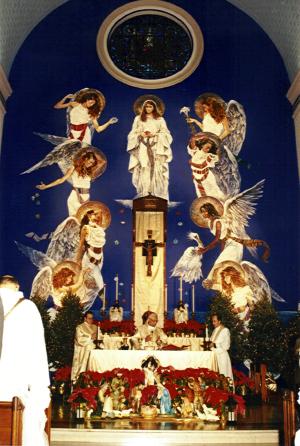Issue Date: January 23, 2004
By DEBORAH HALTER Two years ago, 11 stouthearted parishioners comprised the gospel choir at Our Lady Star of the Sea in eastern New Orleans. Today, the 32-voice choir includes retirees, professionals, students, and an 8-year-old percussionist who is astonishingly comfortable with liturgical music. “They’re good at recruiting,” laughed Richard Cheri, a liturgical musician whose well-focused energy serves this neighborhood church where families walk to Mass and chat on the sidewalk in front of the Greek cruciform edifice. One of those families is his own: He directs the choir, his wife sings, and his 8-year-old son, Richard Cheri II, plays the drums. Our Lady Star of the Sea is in the St. Roch neighborhood, which got its name when a yellow fever epidemic in 1867 prompted a German priest, Peter Thevis, to invoke the intercession of the patron saint of good health. Today the primarily African-American community is home to one of the fastest-growing Catholic congregations in New Orleans. Like the Catholic community at large, the male hierarchy here is apparent on the altar, but most of the males in the congregation at Our Lady Star of the Sea are minors or seniors. The centers of much attention are the matriarchs -- women dressed to the nines with just as many grandchildren gathered around them. These elders clearly hold a place of distinction, and they take their places in the pews with an aura of richness. At Our Lady Star of the Sea, family and community reflect the concept of “liturgy,” which derives from the Greek leitourgia, a religious “public work” performed according to a ritual format. The congregants participate energetically in the Mass. At the offertory, people stand and approach the altar one by one, dropping their gifts into a large, communal basket. The choir provides a musical meditation with harmonies tight and sure, ending in a full-bodied but reverent a capella mantra with strong, haunting notes.
In Black Catholic Worship, Some Reflections (Archdiocese of Chicago, 1999), Bishop Joseph N. Perry has written that the black Catholic “posture and response in liturgy barges through what is practiced as a passive, listening posture peculiar to most European inculturations of the Roman rite,” because many Catholics of color “simply are unable to stand, holding a song booklet or with our hands to our sides, staring ahead in blank silence.” There is no blank silence at Our Lady Star of the Sea in New Orleans. But neither is there any stereotypically Southern black Christian display of unchecked emotion. Without much direction from Rome -- which issues liturgical norms not always conducive to ethnic enrichment -- the congregation is culturally adapting the liturgy to its own ethnic tradition without diluting or distorting the Roman rite. Indeed, their distinctive song and prayer weave liturgies of the Word and Eucharist into an experience of worship that is authentically black and Catholic. Cultural adaptation of the liturgy is important to black Catholics in the United States who, according to Perry, are expected to “sing a preponderance of Teutonic hymns,” or meditate on “religious art and statuary featuring white skin,” or attend Masses “required by some unwritten law to be finished in 50 minutes or less.” Masses at Our Lady Star of the Sea can last twice that long, there are no Teutonic hymns, the highly stylized statuary is ethnically non-distinguishable, and the art is, well, delightfully shocking, at first. Local artist Vernon Dobard painted the striking wall behind the altar, known as “The Dance of Holy Innocence.” The contemporary depiction is of Mary and a retinue of angels, all strikingly beautiful women, representing the ethnic backgrounds of the parish congregants -- French, Spanish, Creole, German and African. This feminine, multiethnic tableau is a graphic departure from the male, hierarchical church leadership, but it reaches far toward representing the congregation it serves. The values of this congregation are reflected in both the liturgy and extra-liturgical activities. During Mass, the people enthusiastically applaud not only after the choir’s breath-stopping “Alleluia” or the homily, but also after an announcement that a group of young people will be collecting money after Mass to provide meals for needy families in the neighborhood. Indeed, there are several collections during the nearly two-hour worship. There is a strong sense of ownership among these congregants, many of whom give from what are clearly slender purses. This sense of sharing pervades the liturgy. The Sign of Peace here is dramatically different from that at a “white” church across town, where the pastor recently explained the “proper words” for the Sign of Peace. Mass-goers there stumbled stiffly through the prescribed, unwieldy greeting then stood in solemn embarrassment to await the “Lamb of God.” At Our Lady Star of the Sea, by contrast, people leave their pews and walk about, shaking hands, hugging, kissing. Imperceptibly, the Sign of Peace gives way to the more solemn “Lamb of God” as the congregation glides back into the pews and joins in singing: “You take away the sins of the world.”
Choir director Cheri explains that rather than signaling the end of one posture and the start of another, the music “affirms the flow” of the liturgy. “Our role is to accompany the liturgy, to lead our prayer through song.” As Mass comes to an end, Fr. Tony Ricard steps down from the altar and calls for those celebrating birthdays and anniversaries to come forward. Ricard is a charismatic pastor who teaches church doctrine at nearby Xavier University, the nation’s only black Catholic university and home to the Institute for Black Catholic Studies. As several Mass-goers gather with him at the foot of the altar to share their special days, the congregation raises a sea of right hands to offer a blessing. Likewise, they pray for themselves and for all persons in their community -- families, children, loved ones living in poverty or surviving in prison. Then, having received blessings from the priest and each other, the congregation and choir slowly leave their church, filling it with thanksgiving in a major key. “The message of the gospel is in the songs we sing,” Cheri says, looking around the arching, domed church. “What we do here is not performance, it’s ministry. We have fun. We have Jesus, and we have fun.” Deborah Halter is a lecturer in World Religions at Loyola University, New Orleans. National Catholic Reporter, January 23, 2004 |

